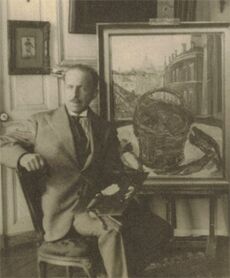Georges Dufrénoy facts for kids
Quick facts for kids
Georges Dufrénoy
|
|
|---|---|
 |
|
| Born |
Georges Dufrénoy
June 20, 1870 Thiais, Île-de-France, France
|
| Died | December 9, 1943 (aged 73) Salles-en-Beaujolais, Rhône, France
|
| Nationality | French |
| Known for | Painting |
Georges Dufrénoy (born June 20, 1870 – died December 9, 1943) was a French painter. He was known for his unique style, which mixed ideas from Post-Impressionism and Fauvism.
Contents
About Georges Dufrénoy
Georges Dufrénoy was born in Thiais, France. His family lived in a historic 17th-century building in Paris. He lived there his whole life.
He went to a Catholic school called école Massillon from age 5 to 17. After school, he had to choose between studying architecture or painting. He decided to become a painter.
Early Art Training
In 1887, Dufrénoy began studying art at the Académie Julian. His teacher was Jean-Paul Laurens. From 1890, he spent two years learning from Désiré Laugier. Laugier taught him a lot about painting.
By 1895, Dufrénoy started showing his own artworks. His early paintings were much like Impressionism. This style uses small, thin brushstrokes to show light and movement.
Discovering Venice
In 1902, Dufrénoy visited Venice, Italy, for the first time. He loved the city so much that he returned almost every year until 1939. He discovered the works of famous Venetian artists there. These included Titian, Tintoretto, and Veronese.
An art critic named Marius-Ary Leblond wrote about Dufrénoy's Venice paintings. He said they followed the "great tradition of the Venetian Masters." This meant Dufrénoy's art felt rich and grand, like the old Italian painters.
Showing His Art
Dufrénoy started showing his paintings in big art shows. In 1903, he showed three paintings at the Salon International de Reims. In 1904, he joined the Salon des Indépendants.
He also became a member of the Salon d'Automne. He later joined its committee and board. He remained loyal to this show for many years. A famous art dealer in Paris, Bernheim-Jeune, bought one of his paintings. It was called "Rue à l'omnibus."
In 1905, he traveled to Italy to paint with his friend Pierre Girieud. Two years later, Marius-Ary Leblond wrote a very positive review of Dufrénoy's art. He said Dufrénoy was one of the best artists of his time.
Art Dealers and Family Life
Dufrénoy's main art dealer was Druet. Druet also supported other famous artists like Bonnard and Derain. After Druet closed in 1934, Katia Granoff became his main dealer.
On January 29, 1914, Georges married Marguerite de Baroncelli-Javon. Her brother, Folco de Baroncelli-Javon, was famous for raising bulls. Her other brother, Jacques de Baroncelli, was a filmmaker. Georges and Marguerite had two daughters and two sons.
Later Years and Legacy
Georges Dufrénoy fought in World War I. After the war, he continued to paint and sell his works. He kept showing his art at the Salon des Indépendants and the Salon d'Automne.
In 1929, he won the Carnegie Prize. He also served on the jury for the Prix de Rome. This was an important award for young artists.
The occupation of France in 1940 made him very sad. He passed away in Salles-en-Beaujolais in 1943.
Where to See His Art
Georges Dufrénoy's paintings are in many museums around the world.
Museums in France
- Musée du Luxembourg: You can see paintings like Le Palais Pisani à Venise.
- Musée National d'Art Moderne - Georges Pompidou (Beaubourg): This museum has his painting Vue de Sienne from 1907.
- Palais de Tokyo: Here you can find Nature morte à la Langouste.
- Musées de la ville de Paris: This group of museums holds several of his works, including Le vieille Hôtel Fieubet à Paris.
- Maison Victor Hugo de Paris: This museum has La maison Victor Hugo à Bruxelles.
- Musée Toulouse-Lautrec d'Albi: You can see Place des Vosges un jour de pluie here.
- Musée des Beaux-Arts de Nantes: This museum has Nature morte au faisan.
Museums Around the World
- Pushkin Museum of Fine Arts in Russia: This museum has L'omnibus Bastille-Madeleine.
- National Museum of Serbia: You can find Nature morte aux fleurs here.
- Carnegie Museums of Pittsburgh in the USA: This museum owns La nature morte au violon.
- Birmingham Museum & Art Gallery in the UK: This museum has La Place des Vosges.
- Chrysler Foundation - Detroit (Michigan) in the USA: This foundation has La place de la Bastille.
- Musée National des Beaux-Arts d'Alger in Algeria: This museum also has a painting called Place des Vosges.
- Musée des Beaux-Arts de Gand in Belgium: This museum has Vue de Sienne.
- Musée royal d'art moderne à Bruxelles in Belgium: This museum has Nature morte au piano-forte et au violon.
Images for kids


